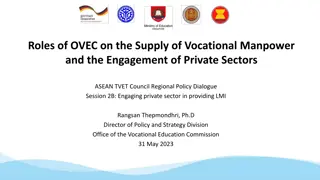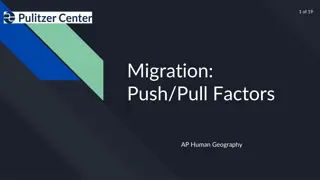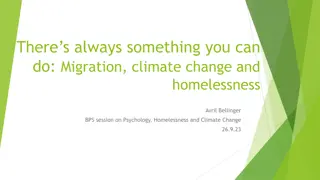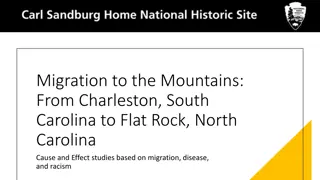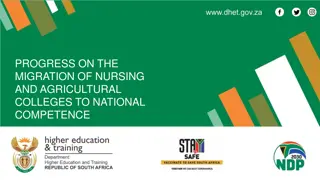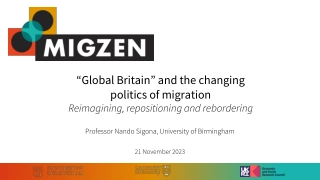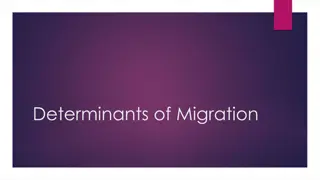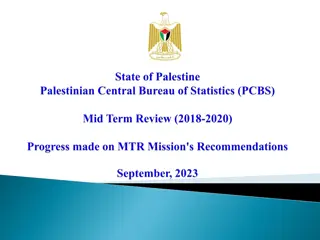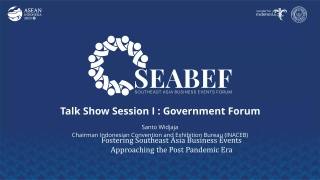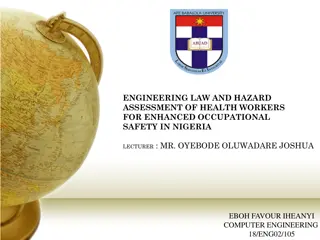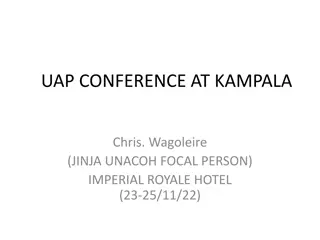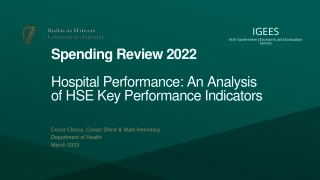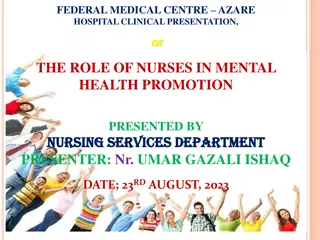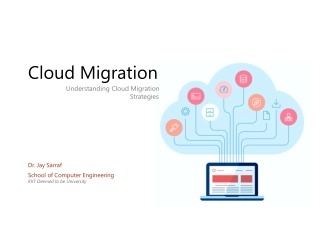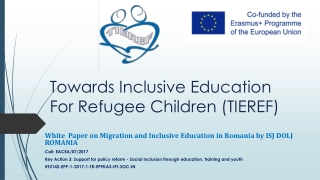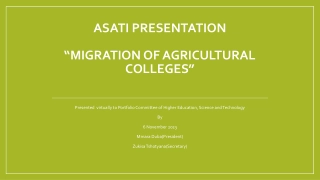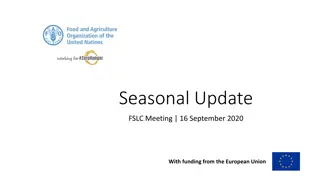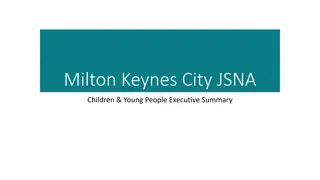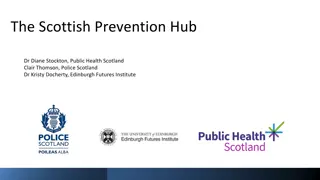Migration and Health in ASEAN: Key Challenges and Recommendations
This study focuses on the health challenges faced by migrant workers in ASEAN countries, highlighting issues such as lack of coordinated governmental efforts, inadequate health services for migrants, and financial barriers to accessing healthcare. Recommendations including improving insurance coverage and establishing a dedicated health information system are proposed to address these challenges.
Download Presentation
Please find below an Image/Link to download the presentation.
The content on the website is provided AS IS for your information and personal use only. It may not be sold, licensed, or shared on other websites without obtaining consent from the author. Download presentation by click this link. If you encounter any issues during the download, it is possible that the publisher has removed the file from their server.
Presentation Transcript
Migration and Health in ASEAN: Regional Case Studies Migration and Health in ASEAN: Regional Case Studies Summary of Key Findings Summary of Key Findings Name of Presenter Organization
ASEAN Post ASEAN Post- -2015 Health 2015 Health Development Agenda Development Agenda The ASEAN Post-2015 Health Development Agenda s mission statement is to promote a healthy and caring ASEAN Community, where the people achieve maximal health potential through healthy lifestyle, have universal access to quality healthcare and financial risk protection; have safe food and healthy diet, live in a healthy environment with sustainable inclusive development where health is incorporated in all policies. In order to succeed in the new health agenda, ASEAN developed goals and lists of health priorities. Specifically, Health Cluster 3, Strengthening Health System and Access to Care, listed migrants health as a priority.
Highlights of Key Challenges in ASEAN Highlights of Key Challenges in ASEAN A lack of multisectoral governmental coordination to address health issues of migrant workers The absence of culturally sensitive and tailored health services for migrants Not all employers complete the obligation of obtaining insurances for migrant workers No legislation which mandates employers to provide health insurance for migrant workers Social health insurance provided by the government has no coordination with overseas providers Migrant workers may face difficulties when attempting to access healthcare When in-patient medical bills exceed MYR 20,000, migrant workers may experience out-of- pocket expenses A lack of No dedicated migrant worker health information system No multisectoral gover nmental coordinati on to address health issues of migrant workers dedicated migrant worker health infor mation system
Structure of Migration and Health in ASEAN: Structure of Migration and Health in ASEAN: Regional Case Studies Regional Case Studies 1 1. . Executive Executive Summary Summary 2 2. . Introduction Introduction 3 3. . Methodology Methodology 4 4. . ASEAN ASEAN Case Case Study Study 5 5. . Migration Migration Health Health Profiles Profiles in in ASEAN ASEAN Countries Countries 6 6. . COVID COVID- -19 19 and and Migration Migration in in ASEAN ASEAN 7. ASEAN Framework on Health Coverage 7. ASEAN Framework on Health Coverage for forDocumented Migrants (annex) Documented Migrants (annex) Developed and supported by: The International Organisation for Migration (IOM) Endorsed by: ASEAN Health Cluster 3, lead countries Philippines and Indonesia (4 Aug 2022) Endorsed by: ASEAN Senior Officials on Health Development (SOMHD) (19 August 2022)
Introduction: Demography and Health Introduction: Demography and Health Population in ASEAN countries (population in thousands, 2019) 300000 266,911.90 250000 200000 150000 108,274.30 96,484.00 100000 67,989.80 54,100.00 50000 32,581.40 16,289.30 7,123.10 5,703.60 459.5 0 Health issues: infectious diseases (HIV/AIDS, TB, and injuries; poor mental health; non-communicable diseases (such as cardiovascular disease and diabetes), and maternal and child health problems within ASEAN. HIV/AIDS, TB, and malaria malaria); occupational health hazards and
Objectives Objectives This report aims to take stock of the recent developments, commitments, efforts and initiatives in the field of migration and health within the ASEAN region. Become an avenue to gather experts on migration and health from ASEAN countries. Take stock of the recent developments and updates on various policies, commitments, efforts and initiatives in the field of migration and health. Provide a platform for dialogue, including the discussions of ideas, experiences and perspectives on migrant health issues among stakeholders relating to the current health issues faced by documented migrants. Conduct assessments and situational analyses of the health coverage amongst documented migrants within ASEAN, including migrant workers and special subpopulation groups (mothers and children).
A scoping review: published data, literature and research published in English from 2018 to 2021 that focused on the health of migrants within the ASEAN member states were collated and analyzed. Key text: The ASEAN Statistical Yearbook 2020. Recommendations from the assessment and situational analysis tool: a workshop was organized to develop guidelines on health coverage for documented migrants including migrant workers and special subpopulations. Methodology Methodology Limitations: Verification; Exclusion of non- English texts; Inclusion of documented migrants.
ASEAN Case Studies: ASEAN Case Studies: General Migration Trends and Health General Migration Trends and Health Out of the total labour force of 326 million in ASEAN, over 7 million ASEAN population work overseas in other ASEAN country. over 7 million of the The ASEAN member countries signed the Declaration on the Protection Promotion of the Rights of Migrant Workers Promotion of the Rights of Migrant Workers (2007). the Declaration on the Protectionand and The devastating and disproportionate impact of COVID devastating and disproportionate impact of COVID- -19 on has strongly highlighted the need for including migrants within national healthcare policies. 19 on migrants migrants within ASEAN ASEAN Health Cluster 3 (AHC 3) ASEAN Health Cluster 3 (AHC 3): "Strengthening Health System and Access to Care, listed migrants health as a priority.
ASEAN Case Studies: ASEAN Case Studies: Regional and International Frameworks on Migration Health Regional and International Frameworks on Migration Health Legal Frameworks Related to Migration Health Legal Frameworks Related to Migration Health Ratified Countries Ratified Countries ASEAN Consensus on the Protection and Promotion of the Rights of ASEAN Consensus on the Protection and Promotion of the Rights of Migrant Workers Migrant Workers (2018) (2018) All AMS All AMS ASEAN Declaration on the Protection and Promotion of the Rights of ASEAN Declaration on the Protection and Promotion of the Rights of Migrant Workers (2007) Migrant Workers (2007) All AMS All AMS ASEAN Convention Against Trafficking in Persons, Especially Women and ASEAN Convention Against Trafficking in Persons, Especially Women and Children (2015) Children (2015) All AMS All AMS ASEAN Declaration on Strengthening Social Protection (2013) ASEAN Declaration on Strengthening Social Protection (2013) All AMS All AMS Employment Order Employment Order Brunei Darussalam, Malaysia, Singapore, Viet Brunei Darussalam, Malaysia, Singapore, Viet Nam Nam International Convention on the Protection of the Rights of All Migrant International Convention on the Protection of the Rights of All Migrant Workers and Members of their Families (1990) Workers and Members of their Families (1990) Cambodia, Indonesia, Philippines Cambodia, Indonesia, Philippines Universal Declaration of Human Rights (1948) Universal Declaration of Human Rights (1948) All AMS All AMS Convention Relating to the Status of Refugees (1951) Convention Relating to the Status of Refugees (1951) Cambodia, Philippines Cambodia, Philippines Migration for Employment Convention (1949) Migration for Employment Convention (1949) Philippines Philippines Domestic Workers Convention (2011) Domestic Workers Convention (2011) Philippines Philippines
Migration Health Profile of Migration Health Profile of Brunei Darussalam Brunei Darussalam Health Content Content Migration Number/Type Number/Type Governance The implementation of both national and international legislation. Documented migrants 71,713 in 2019 Financing Total health expenditure: 2.27% of GDP 2.27% of GDP Occupation of documented migrant workers Low Low- -skilled: 35.1% skilled: 35.1% Basic health services e.g., primary healthcare services, maternal and child health services, are provided to its citizens, free of charge. Services and Sales: 17.7% Semi-skilled: 16.7% Service Delivery Health services for documented migrants documented migrants are provided through government funding, private health insurance and out of pocket payments. Industry Construction: 30.1% Wholesale and retail trade, repair: 17.5% Accommodation and food service: 12.6% Health Information System Challenges The Department of Policy and Planning of the Ministry of Health Brunei Darussalam Manufacturing and others: 12.3% Migrant stock by origin The most of them are from Indonesia, Bangladesh, Philippines, India among others Not all employers obtain adequate medical and Not all employers obtain adequate medical and workmen compensation workmen compensation insurance coverage; Lack of effective information system; Disaggregated data data Disaggregated
Migration Health Profile of Migration Health Profile of Cambodia Cambodia Health Content Content Migration Number/Type Number/Type Governance (1) Legal framework: Laws, Subdecree, Prakas, MoU, Regional legal framework Internal migration 4 4. .1 1 million million internal internal migrants migrants in in 2013 2013 Rural-to-rural (58.4%) (2) Multistakeholder collaboration Total health expenditure: 5.8 % of GDP Rural-to-urban (24.5%) Financing 5.8 % of GDP in 2018 International migration 2.6% of the total migrants within Cambodia Service Delivery Health services for documented migrants documented migrants are provided through government funding, private health insurance and out of pocket payments. Viet Nam: 37,225 (origin) Thailand: 750,109 (destination) The large number of private health are loosely regulated are loosely regulated while the public sector is dominant in the promotion and prevention activities of essential reproductive, maternal, neonatal and childcare health, and major communicable diseases control. private health- -care providers care providers Outbound migrants "3D" Jobs "3D" Jobs: dirty, difficult and dangerous Agriculture, livestock, construction, manufacturing, fishing and service industries
Migration Health Profile of Migration Health Profile of Indonesia Indonesia Types of migration Types of migration Number Number Health Content Content Governance A robust health governance structure, bilateral labour agreements. Social Health Insurance (SHI): 17.3%; Private Health Insurance (PHI) and Health Maintenance Organizations (HMO): 3.2%; Government: 31.5%; Private sectors, Non-Profit sectors: 13%; Out-of- Pocket Payments: 35%. Workers should also be covered by the Manpower Social Security Organizing Agency (BPJS Ketenagakerjaan) through a) accident insurance; b) pension plan; c) pension guarantee; and d) life insurance. Data on migration and migrant workers are available Documented immigrants Cumulative emigrant in 2018 Migrant worker top destination 157,792 Financing 2,989,306 1) Malaysia (77,888), 2) Taiwan (282,167), 3) Hong Kong (152,532) Service Delivery Occupation of documented emig rants 1. Domestic Worker: 239,803 2. Care Giver: 131,337, 3. Plantation Worker: 119,673, 4. Operator: 95,014, 5. Worker: 64,943 1) Professional: 27,451 2) Manager: 21,060 3) Director: 16,371 4) Advisor/Consultant: 13,498 5) Technician: 10,034 6) Commissioner: 2,256 7) Supervisor: 2,223 Occupation of documented immigrants Health Information System Challenges No coordination with overseas providers and for Indonesian outbound migrants; Health insurance coverage for all Indonesian migrant workers is yet to be regulated and still operates as a voluntary system.
Migration Health Profile of Migration Health Profile of Lao PDR Lao PDR Health Governance Content Content The health-care system is government-owned, with three administrative levels: central (Ministry of Health), provincial (provincial health offices) and district level (district health offices). Out Out- -of of- -pocket spending pocket spending is the largest source of health financing: 45.1% in 2016. Health share of 6% of the national budget is low compared to other countries in the region Health financing depends on external sources for some priority health programs such as TB, Malaria, some priority health programs such as TB, Malaria, and immunization. and immunization. Health services available for documented migrants Type of migrant Type of migrant Number Number Documented migrants 22,260 Female migrants 5,569 Financing Documented migrant workers 22,260 Top origin and destination Origin: Viet Nam (11,447) external sources for Destination: Thailand (926, 427) Service Delivery Occupation of documented migrant workers Health and cosmetic provider, engineer, miner, financing, international auditor, agriculture, industry service sector. Health Information System Challenges The Ministry of Health is responsible for health information Sources of payment are not clear No multisectoral coordination
Migration Health Profile of Migration Health Profile of Malaysia Malaysia Health Health Governance Content Content Legal Framework and Bilateral Labour Agreements Migrant Migrant type type Number Number Data Datasource source Year Year Financing The Foreign Workers Hospitalization and Surgical The Foreign Workers Hospitalization and Surgical Insurance Scheme (SPIKPA) Insurance Scheme (SPIKPA) This annually renewable health insurance plan is restricted to foreigners aged 18 45 years at time of initial application for the work permit. Through more than 3,000 static public primary care facilities and 146 public hospitals The rural population are served through an extensive network of health clinics and mobile health teams. The private sector has also developed and evolved alongside the government delivery system and is particularly strong in the urban areas. Several divisions within Ministry of Health and other Ministries such as the Home Ministry store and update data on migrant workers The limitations of SPIKA Documented mi grants 918, 883 FOMEMA 2017 Service Delivery Female migrants 439,404 SPIKPA Data (MOH) 2016 Health Information System Challenges Migrants under 18 years old 28 SPIKPA Data (MOH) 2016
Migration Health Profile of Migration Health Profile of Myanmar Myanmar Health Health Governance Content Content A robust health governance structure with numerous legal frameworks Top 4 countries of origin Top 4 countries of origin (inbound migrants) (inbound migrants) Top 5 countries of Top 5 countries of destination destination (outbound migrants) (outbound migrants) A multistakeholder national framework Total health expenditure: 2.27% of GDP Financing China 47,742 Thailand 1,892,480 Service Delivery Article 24(a) of the Overseas Employment: claim full compensation for any work-related injury. In practice: this provision is usually omitted from the standard agreement India 37,004 Malaysia 247,768 Health There is limited data on migration in Myanmar and there is no specific Migrant Health Management Information System. Lack of access to primary health-care services Absence of culturally sensitive health services Lack in continuity of care Non-inclusion of health service provision for migrants in bilateral agreements. Pakistan 3,683 Bangladesh 197,625 Information System Challenges Bangladesh 1,648 USA 98,344 Pakistan 93,057 Total 90,077 Total 2,529,274
Migration Health Profile of Migration Health Profile of Philippines Philippines Health Health Governance Content Content International, national laws, and bilateral agreements Healthcare is mainly provided by the state owned, single payer social health insurance scheme (Phil health) and 92% of the population is covered through Phil health. Around 371,000 document migrants and 335,000 migrant workers were enrolled in the social health insurance scheme in 2018. Around 10 million Philippine citizens work or live overseas and around 4.2 million of them are enrolled in PhilHealth Overseas Filipinos programme Covers the dependents of the migrants. Types Types of of migrants migrants Numbers Numbers Documented 177,368 Financing Female migrants 3,034 Documented migrant workers 12,218 Occupation of documented migrants Administrative, executive, and managerial workers (56.1%); Technicians and associate professionals (36.4%); Professionals (5.9%); Service workers and shop and market sales workers (1.5%); Farmers, forestry workers, and fishermen (0.1%) Service Delivery Information Multiple stakeholders are responsible Only 4.2 million out of the 10 million Filipinos abroad, or around 42 per cent, are enrolled in PhilHealth. High out-of-pocket health expenses at around 55 per cent in the Philippines. Enhancing multisectoral collaboration on the management of health of migrants. Occupational- related injuries 1.08 per thousand Challenges Deported migrant workers 1,508 Top origin and destination Origin: China (36,171) Destination: USA (3,176,208)
Migration Health Profile of Migration Health Profile of Singapore Singapore Health Health Content Content Country Country Number Number Governance The Employment of Foreign Manpower Act (EFMA) The Foreign Employee Dormitories Act Total health expenditure: 5% of GDP Total health expenditure: 5% of GDP Health financing for foreigners is provided mainly through private health insurance provided by the employer or is self-funded Country Country or or area area of of origin origin Malaysia 1,044,994 Financing China 380,766 Indonesia 152,681 India 136,177 Service Delivery Ensure that everyone has access to different levels of healthcare in a timely, cost-effective and seamless manner. Pakistan 118,765 Health Information System Singapore does not have dedicated migrant worker health information system. However, Ministry of Manpower (MOM) Ministry of Manpower (MOM) requires employers to purchase medical insurance for the duration of the work pass and provide MOM with information on the insurer and policy number. Balance the need for adequate insurance cover for large medical bills with the need to maintain affordable insurance premiums. Country Country or or area area of of destination destination Malaysia 78,092 Australia 63,077 UK of Great Britain & Northern Ireland 41,143 Challenges USA 37,106 Indonesia 19,681
Migration Health Profile of Migration Health Profile of Thailand Thailand Health Health Content Content Categories of migrants in Thailand Number % Governance Multiple legal frameworks and provisions implemented Social Security Scheme (SSS) Civil Servant Medical Benefit Scheme (CSMBS) Medical Welfare Scheme (MWF) Universal Care Scheme (UCS) A significant number of Thai nationals undergo pre- departure health assessments Premium of MOPH scheme Migrant Worker Assistance Centres Health Information System migrants (Nationality, Gender, Age, Occupation, Hospital, Birthdate, Name and Last name, CID) are done by the Ministry of Public Health (MOPH). Challenges Some migrants face difficulties in accessing SSS The percentage of migrants registered with MPH is low Irregular and undocumented migrants Financing Professional and skilled workers 112,834 2.81 Work permits issued to migrants entering through MOU 850,302 21.20 Service Delivery Work permits issued to migrants registered in Thailand 2,214,298 55.21 Real time data collection, storage, issuance of national ID card, collection of data specific to documented Seasonal work permits 21,561 0.54 Irregular status 811,437 20.23 Total 4,010,432 100
Migration Health Profile of Migration Health Profile of Viet Nam Viet Nam Health Health Content Content Country Country Number Number Governance Multiple legal frameworks and provisions implemented Country Country or or area area of of origin origin Financing Total health expenditure: 5% of GDP The out-of-pocket payments for healthcare are still at a high level in Viet Nam and accounted for 48.8% in 2012. Social health insurance (SHI) program Most of documented migrants are covered by SHI since it is requested by law for anyone who has labour contract to enroll in SHI. No cross-border referral systems and collaboration exist Inconsistency in policy implementation Monitoring systems of migrant populations is still incomplete Limited health communication programme Mistrust in health services Limited understanding and knowledge of migrants on access to health-care services Libyan Arab Jamahiriya 11,278 Myanmar 9,783 China 8,629 Service Delivery Indonesia 7,671 Lao PDR 4,284 Challenges Country Country or or area area of of destination destination USA 1,381,076 Australia 225,749 Canada 184,799 France 123,638 Republic of Korea 122,449
COVID COVID- -19 and Migration in 19 and Migration in ASEAN ASEAN The COVID-19 pandemic has had calamitous impacts on all countries within ASEAN, with migrants being amongst those who have been disproportionally harmed and affected (UNESCAP, 2020). Due to strict entry and exit barriers applied by origin and destination countries within ASEAN during 2020, outflows of migrant workers significantly decreased Migrant workers have been infected with COVID-19 at significantly higher rates compared to their respective host communities Health impacts: Migrants are the usually the first subpopulation to be triaged out national health emergency and preparedness plans Socioeconomic impacts: COVID-19 has severely disrupted the flow of remittances Migrants should and must be included in national social protection measures in their host countries. Migrants should and must be included in national social protection measures in their host countries.
COVID COVID- -19 Related Policies across ASEAN (as of April 2022) 19 Related Policies across ASEAN (as of April 2022)
ASEAN Framework on ASEAN Framework on Health Coverage for Health Coverage for Documented Migrants Documented Migrants including Migrant including Migrant Workers and Special Workers and Special Populations Populations (SOMHD endorsed 25 July (SOMHD endorsed 25 July 2022) 2022)
Contact: Contact: ROBangkokMigrationHealth@iom.int ROBangkokMigrationHealth@iom.int Tel: +66 2 343 9404, +66 2 343 9416 Tel: +66 2 343 9404, +66 2 343 9416 Regional Migration Health Unit Regional Migration Health Unit IOM Regional Office for Asia and the Pacific IOM Regional Office for Asia and the Pacific


